Art of the Sea: In Words
Part two of BBC4's Art of the Sea focused on the sea in words. Owen Sheers presented quite a personal overview of the influence of the sea on British literature and he began with Patrick O’Brian.
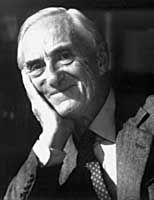
Patrick O'BrianNelson’s naval battles provided O’ Brian with ready-made theatre on a grand scale. His success, with three millions copies of this books sold before his death in 2000, rests on his vivid and extraordinarily detailed depiction of the period. Indeed O’Brian is more famous for his depiction of period life than his depiction of naval action and in Stephen Maturin he encapsulates the role of the sea in scientific discovery.
David Cordingly described Peter Weir’s reconstructions of O’Brian’s battle scenes in Master and Commander as “as vivid and authentic as any I’ve read of. He creates a feeling of noise and confusion and limbs being torn apart but the crew are getting on with their job and know what to do. Aubrey is a big man, 6ft 16 stone, with flaxen hair and a florid complexion, he is clumsy on land but on a ship knows exactly what to do. Russel Crow shares with Aubrey a sense of command and of leadership. The great thing about O’Brian, more than any other author is that he creates a world you believe in.”
O’Brian shows how the sea is an ideal setting for conflict. People’s nature changes at sea, they can become heroes, villains, cowards. Ships are a microcosm of society. When you set sail you enter a different world. Sea voyages are a transgression; there is a real sense of a strand being cut when you cast off from the quay.

Joseph ConradSheers turned next to the theme of the sea as enemy with Joseph Conrad’s Nigger of the Narcissus, a title which he acknowledges few authors would be consider today. The book which is informed by Conrad’s own 16 years in the merchant navy focus on black sailor Jimmy Wait, an ailing, brooding presence who comes to be invested with supernatural significance. Conrad was writing from personal experience and his aim was to provide a voice for inarticulate seamen and to render justice for them. He was also fascinated by the vastness of sea; his characters are terrified by the vastness of the universe. The sailors of the Narcissus come to believe their lives are tied up with Jimmy’s so when he is trapped during a storm they mustrescue him. The buried compassion of the sailors is brought out by their superstitious concern for Jimmy. Although Conrad was very aware of the supernatural quality of the sea he always gives you a rational escape route. Conrad brings out the atheist in the atheist, the believer in the believer, the agnostic in the agnostic and he trusts the high seas to bring out the irrational in man.
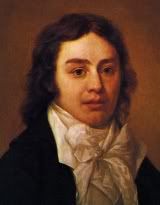
Samuel Taylor ColeridgeThe sea is almost human in its moods, when it’s pounding in our ears it’s the sound of all history. Characters are changed by being at sea, this idea of transformation has always been the backbone of stories at sea.
The sea isolates you from everything that makes you feel safe and the sea can challenge your reason and warp your perception as well. In Samuel Taylor Coleridge’s the Rhyme of the Ancient Mariner the sea is a wilderness, the kind of environment that can provoke spiritual reflection and despair. The Mariner is a story of psychic disturbance. As the men on the becalmed ship start to die, being to the sea comes to represent the stark desperation of being hundreds of miles from anywhere. The mariner himself does return home but is fundamentally changed ad is doomed to tell his retell is harrowing tale.
In the greatest stories of the sea characters are forced to face challenges. You cant run away from problems at sea, when a storm hits a ship everyone is in the same danger.
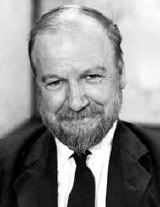
William GoldingWiliam Golding’s Rites of Passage, the first book in his sea trilogy To the Ends of the Earth, brings together his two preoccupations; the sea and morality. Golding’s ship is a theatre and the characters a microcosm of English society 200 years ago. The story is told through he eyes of Edmund Talbot who witnesses the breakdown of another passenger Reverend Colley. Everything changes when Colley gets drunk and frolics naked with a seaman. Colley has performed a homosexual act and is a changed man thereafter, he confines himself to his cabin and dies of an overwhelming sense of shame. Rites of Passage is based on the ritual of crossing the line (crossing the equator) the rite of passage where the rules don’t apply. The book includes extraordinary seascape passages that come from the core of Golding as writer. Golding himself served in the navy during the second world war and was a keen sailor.
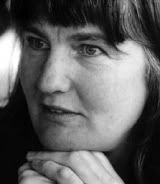
Margaret ElphinstoneMost sea writers are men and sea literature feature storms, battles and all male crews. Charles Kingsley understood that the sea had many faces and both feminine and masculine qualities. Do men and women view the sea differently? Westward Ho is not just a swashbuckler, it shows a surprising interest in how women are changed by the sea. For women the sea is fraught with anxiety, of waiting, for her the sea symbolises death. Kingsley was a protofeminist in his own way, often describing events through the eyes of the mother
Margaret Elpinstone describes the image of the woman waiting for the ship that never comes as an archetypal but passive role of endurance. There are no women at sea so women readers of sea fiction have to be position themselves as men. If you start worrying about gender and where the women are you can’t get into it so you have to become a “reading man”. The greatest sea novels written by women take place on land such as Virginia Wolfe’s To the Lighthouse. To Wolfe the sea is feminine, it’s inchoate, it’s other, it’s always there like an element.
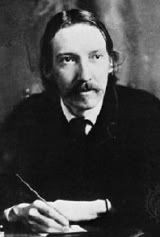
Robert Louis StevensonRobert Louis Stevenson is largely responsible for our current perception of pirates and created the archetypal pirate in Captain Hook. Although he never met any pirates he read a lot from Captain Johnson A General History of the Robberies and Murders of the most notorious Pyrates history written in 1724 at the height of the Caribbean pirate problem. Treasure Island is pure theatre with a strong theatrical character in Silver*. Stevenson also explored the sea as theatre and the theme of ship wreck in Kidnapped. David Balfour is cast up following the wreck of the Covenanter on the island of Erraid (cue shot of drenched Sheers on dreich west coast of Scotland) where he barely survives before he realises the island is in fact tidal. It is a high point of comedy in the novel, with Stephenson poking fun at his own character and at the idea that Balfour will always be a captive. The bay on the island of Erraid, off Mull, is now known as Balfour bay.
Sheers concluded by asking just how alien is the sea in literature? Authors’ view the sea as an entirely other realm, we are reminded that once out there everything changes, it’s another word. The sea is as likely to punish as to inspire but the lure of the sea voyage is tremendous. By following these voyages we can arrive at a different perception of self. We are islands, the sea surrounds us and defines us.
* While talking about Stevenson, the programme cut to clips of a 1968 tv production of Treasure Island featuring Peter Vaughan as Long John Silver. That’s the same Peter Vaughan who plays Admiral Lord Hood in The Frogs and Lobsters. See? There had to be a Hornblower connection there somewhere! (Incidentally Robert Vaughan also played Robert Lindsay’s prospective father-in-law in Citizen Smith. Oh yes, I am old enough to remember the Tooting Popular Front ;)
(And for those of you who can’t be bothered with a long summary, here’s a short summary of the long summary: Cordingly spoke about O’Brian and Weir; Sheers covered Conrad, Coleridge, Golding, Kingsley and Stevenson; Margaret Elphinstone talked about reading sea literature from a woman’s perspective; no mention of Forester but one tenuous connection with Hornblower ;)

Patrick O'BrianNelson’s naval battles provided O’ Brian with ready-made theatre on a grand scale. His success, with three millions copies of this books sold before his death in 2000, rests on his vivid and extraordinarily detailed depiction of the period. Indeed O’Brian is more famous for his depiction of period life than his depiction of naval action and in Stephen Maturin he encapsulates the role of the sea in scientific discovery.
David Cordingly described Peter Weir’s reconstructions of O’Brian’s battle scenes in Master and Commander as “as vivid and authentic as any I’ve read of. He creates a feeling of noise and confusion and limbs being torn apart but the crew are getting on with their job and know what to do. Aubrey is a big man, 6ft 16 stone, with flaxen hair and a florid complexion, he is clumsy on land but on a ship knows exactly what to do. Russel Crow shares with Aubrey a sense of command and of leadership. The great thing about O’Brian, more than any other author is that he creates a world you believe in.”
O’Brian shows how the sea is an ideal setting for conflict. People’s nature changes at sea, they can become heroes, villains, cowards. Ships are a microcosm of society. When you set sail you enter a different world. Sea voyages are a transgression; there is a real sense of a strand being cut when you cast off from the quay.

Joseph ConradSheers turned next to the theme of the sea as enemy with Joseph Conrad’s Nigger of the Narcissus, a title which he acknowledges few authors would be consider today. The book which is informed by Conrad’s own 16 years in the merchant navy focus on black sailor Jimmy Wait, an ailing, brooding presence who comes to be invested with supernatural significance. Conrad was writing from personal experience and his aim was to provide a voice for inarticulate seamen and to render justice for them. He was also fascinated by the vastness of sea; his characters are terrified by the vastness of the universe. The sailors of the Narcissus come to believe their lives are tied up with Jimmy’s so when he is trapped during a storm they mustrescue him. The buried compassion of the sailors is brought out by their superstitious concern for Jimmy. Although Conrad was very aware of the supernatural quality of the sea he always gives you a rational escape route. Conrad brings out the atheist in the atheist, the believer in the believer, the agnostic in the agnostic and he trusts the high seas to bring out the irrational in man.

Samuel Taylor ColeridgeThe sea is almost human in its moods, when it’s pounding in our ears it’s the sound of all history. Characters are changed by being at sea, this idea of transformation has always been the backbone of stories at sea.
The sea isolates you from everything that makes you feel safe and the sea can challenge your reason and warp your perception as well. In Samuel Taylor Coleridge’s the Rhyme of the Ancient Mariner the sea is a wilderness, the kind of environment that can provoke spiritual reflection and despair. The Mariner is a story of psychic disturbance. As the men on the becalmed ship start to die, being to the sea comes to represent the stark desperation of being hundreds of miles from anywhere. The mariner himself does return home but is fundamentally changed ad is doomed to tell his retell is harrowing tale.
In the greatest stories of the sea characters are forced to face challenges. You cant run away from problems at sea, when a storm hits a ship everyone is in the same danger.

William GoldingWiliam Golding’s Rites of Passage, the first book in his sea trilogy To the Ends of the Earth, brings together his two preoccupations; the sea and morality. Golding’s ship is a theatre and the characters a microcosm of English society 200 years ago. The story is told through he eyes of Edmund Talbot who witnesses the breakdown of another passenger Reverend Colley. Everything changes when Colley gets drunk and frolics naked with a seaman. Colley has performed a homosexual act and is a changed man thereafter, he confines himself to his cabin and dies of an overwhelming sense of shame. Rites of Passage is based on the ritual of crossing the line (crossing the equator) the rite of passage where the rules don’t apply. The book includes extraordinary seascape passages that come from the core of Golding as writer. Golding himself served in the navy during the second world war and was a keen sailor.

Margaret ElphinstoneMost sea writers are men and sea literature feature storms, battles and all male crews. Charles Kingsley understood that the sea had many faces and both feminine and masculine qualities. Do men and women view the sea differently? Westward Ho is not just a swashbuckler, it shows a surprising interest in how women are changed by the sea. For women the sea is fraught with anxiety, of waiting, for her the sea symbolises death. Kingsley was a protofeminist in his own way, often describing events through the eyes of the mother
Margaret Elpinstone describes the image of the woman waiting for the ship that never comes as an archetypal but passive role of endurance. There are no women at sea so women readers of sea fiction have to be position themselves as men. If you start worrying about gender and where the women are you can’t get into it so you have to become a “reading man”. The greatest sea novels written by women take place on land such as Virginia Wolfe’s To the Lighthouse. To Wolfe the sea is feminine, it’s inchoate, it’s other, it’s always there like an element.

Robert Louis StevensonRobert Louis Stevenson is largely responsible for our current perception of pirates and created the archetypal pirate in Captain Hook. Although he never met any pirates he read a lot from Captain Johnson A General History of the Robberies and Murders of the most notorious Pyrates history written in 1724 at the height of the Caribbean pirate problem. Treasure Island is pure theatre with a strong theatrical character in Silver*. Stevenson also explored the sea as theatre and the theme of ship wreck in Kidnapped. David Balfour is cast up following the wreck of the Covenanter on the island of Erraid (cue shot of drenched Sheers on dreich west coast of Scotland) where he barely survives before he realises the island is in fact tidal. It is a high point of comedy in the novel, with Stephenson poking fun at his own character and at the idea that Balfour will always be a captive. The bay on the island of Erraid, off Mull, is now known as Balfour bay.
Sheers concluded by asking just how alien is the sea in literature? Authors’ view the sea as an entirely other realm, we are reminded that once out there everything changes, it’s another word. The sea is as likely to punish as to inspire but the lure of the sea voyage is tremendous. By following these voyages we can arrive at a different perception of self. We are islands, the sea surrounds us and defines us.
* While talking about Stevenson, the programme cut to clips of a 1968 tv production of Treasure Island featuring Peter Vaughan as Long John Silver. That’s the same Peter Vaughan who plays Admiral Lord Hood in The Frogs and Lobsters. See? There had to be a Hornblower connection there somewhere! (Incidentally Robert Vaughan also played Robert Lindsay’s prospective father-in-law in Citizen Smith. Oh yes, I am old enough to remember the Tooting Popular Front ;)
(And for those of you who can’t be bothered with a long summary, here’s a short summary of the long summary: Cordingly spoke about O’Brian and Weir; Sheers covered Conrad, Coleridge, Golding, Kingsley and Stevenson; Margaret Elphinstone talked about reading sea literature from a woman’s perspective; no mention of Forester but one tenuous connection with Hornblower ;)